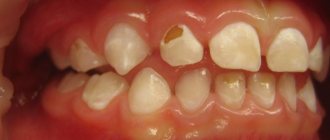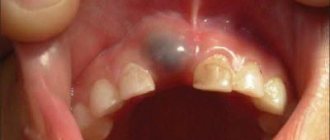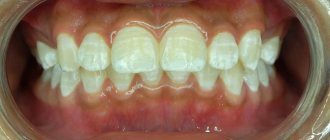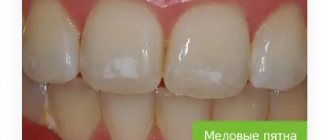Many parents sooner or later wonder why white spots form on their child’s front and chewing teeth. This phenomenon can occur for many reasons, so it is important to consult a doctor as soon as possible to identify them and then prescribe effective treatment.
If the problem is not associated with a pathological process and is just an aesthetic defect, you can cope with it by following the dentist’s recommendations at home. When the situation is advanced, serious dental intervention in the clinic using a drill and filling cavities cannot be avoided.
It is better to prevent pigmentation from occurring, because the problem is much easier to prevent than to treat. Experts have developed a set of recommendations that help prevent the appearance of whitish spots.
White spots on baby teeth in an infant and older child
This is an alarming symptom that requires urgent consultation with a pediatric dentist. Some parents mistakenly believe that there is no need to treat the first teeth, because they will soon fall out and be replaced by permanent ones. This is a misconception that can cost your oral health.
Whitening of areas indicates their demineralization. If urgent measures are not taken, the unit may simply fall out or split into several fragments. As a result, the rudiments of new incisors, canines and molars are damaged. You won't be able to deal with this on your own. For treatment, therapeutic tactics are developed together with an experienced specialist in the field of pediatric dentistry.
Possible reasons
The white color of the enamel layer indicates not only the absence of serious problems with the oral cavity, but also the normal state of health of the child as a whole. Brown baby teeth are an abnormal phenomenon that requires mandatory diagnosis and consultation with a pediatric dentist. Sometimes such a problem “goes away” along with a change in bite, but in many cases such a violation becomes the cause of numerous pathologies in the already permanent dentition.
Plaque
It is a dense formation consisting of proteins, polysaccharides, lipids, and inorganic substances, which are an excellent environment for the development of bacterial flora. It is predominantly concentrated in the cervical region (in the place where the dentin comes into contact with the gum), in the fissures of the molars. Dealing with this problem is simple: all you need to do is follow the rules of daily hygiene. Otherwise, a brown coating appears, and it is not always possible to remove it yourself.
Enamel hypoplasia
It develops due to disturbances in the metabolic processes of formation and mineralization, often even before eruption and even during intrauterine development. The etiology of the disease may be associated with:
- severe infections suffered in infancy;
- rickets;
- nutritional dystrophy;
- endocrine disorders;
- pathologies of the gastrointestinal tract.
The disease most often affects canines and premolars and is accompanied by the appearance of spots, depressions, and grooves of various shapes and sizes. In severe cases of the disease, the child complains of pain during hygiene procedures and reacts to the temperature of food.
Fluorosis
Fluoride is necessary for the full formation and development of both temporary and permanent teeth. But its excessive intake into the body (as a rule, this occurs due to the increased fluoride content in drinking water - up to 1.2–1.5 mg/l or more), especially with a concomitant calcium deficiency in food, leads to the opposite effect - gradual destruction of the enamel coating. This is what causes brown baby teeth to appear.
Caries
It develops against the background of gradual “dissolution” of enamel and damage to dentin by microbial flora. Recently, caries is diagnosed much more often. Experts explain this by the action of various unfavorable factors that prevent the maturation and resistance of the enamel coating. These include:
- changes in the composition of the oral microflora;
- excessive consumption of sweets;
- decreased secretory activity of the salivary glands;
- unbalanced diet;
- failure to comply with hygiene rules.
Other reasons
- hemolytic jaundice: indirect bilirubin formed during hemolysis of red blood cells and causes brown plaque on baby teeth in children;
- taking certain antibiotics (especially from the tetracycline group), drugs with a high iron content by the mother in the second half of pregnancy or by the child during the formation of the bite;
- chronic inflammatory process of the gums and oral mucosa.
White spots on molars
This phenomenon occurs much less frequently than in the case of dairy rows. The process is often observed when installing a bracket system. The problem is provoked by an unbalanced, irregular diet, insufficient consumption of fresh vegetables and fruits, and milk. If this is really the root cause, it is enough to change the diet or reinstall the corrective orthodontic structure.
In adolescence, whitened areas often indicate the onset of caries development. If you contact a dental clinic in a timely manner, you will not need drilling of the affected tissue, filling or cleaning of canals after forced removal of the nerve.
Causes of white spots on a child’s teeth
The problem can arise due to many factors. The most common of them:
- Hypoplasia. This is severe thinning, partial or complete absence of enamel.
- Caries. A natural result of poor quality care and untimely visit to the dentist for preventive purposes.
- Fluorosis. This term refers to an excessive concentration of fluoride in a child’s body.
- Wearing orthodontic appliances. Hygiene is difficult, so carious lesions often occur.
- Injury (including dairy rows).
- Decreased immune defense, frequent colds, viral infections.
- Failure to comply with simple hygiene requirements.
It is worth dwelling on each of the reasons for the occurrence of white spots on teeth in infants and children of an older age category.
Enamel hypoplasia
This is a congenital non-carious pathology of dental units, when a complete or partial absence of the enamel layer is diagnosed. The appearance of incisors, canines and molars changes significantly. Not only whitish areas appear on them, but also grooves and depressions.
The disease is associated with the abnormal structure of hard tissues. It is often accompanied by carious lesions, increased sensitivity to hot and cold foods, sour and sweet foods.
The anomaly originates during the period of intrauterine development or under the influence of external factors. Most often the problem is provoked by:
- Rh conflict between mother and fetus;
- infections suffered by a pregnant woman;
- late gestosis, premature delivery, birth injuries;
- poor nutrition of the expectant mother, taking prohibited medications;
- traumatic effects on the baby’s maxillofacial area;
- endocrine disorders;
- diseases of the gastrointestinal tract, nervous and urinary systems.
Caries
If white spots appear on a child’s teeth, mom and dad most often do not even suspect the presence of carious lesions. The sooner the problem is diagnosed, the faster and easier it will be solved. In the earliest stages, it is often possible to avoid drilling with a drill, which is extremely important when treating small patients. In this case, remineralization or fluoridation is used.
If you do not intervene in time, the enamel will become even thinner, softer and begin to collapse. You can feel the rough surface to the touch.
The spots remain whitish for a short time, they darken. At the same time, infectious agents penetrate into the deepest layers of the crown and root, causing more serious dental diseases that are difficult to treat.
Excess or lack of fluoride
Excessive concentration of the substance in the body is called fluorosis. It reaches a small person through drinking (in some regions the water supply contains excessively fluoridated water), food (seafood), pastes, medicines and polluted industrial air.
Growing teeth are most susceptible to damage, so the problem is more often detected in children. Children with weak immunity and chronic pathologies are especially vulnerable.
Not only excess, but also deficiency of fluoride can provoke a number of dental disorders. Low fluoride content leads to caries and gum disease.
Braces and the consequences of wearing braces
White spots on a child’s permanent (molar) teeth (photos can be found on the Internet) are also observed when orthodontic appliances are installed. This is primarily due to insufficient hygienic care of the oral cavity. In children wearing braces, a layer of plaque accumulates, and the enamel may become lighter.
During the correction period, it is important to take good care of your incisors, canines and molars. It is worth cleaning them at least 2 times a day, morning and evening. You need to give up sweets, confectionery, and sour foods. All this leads to pigmentation.
Injuries
Any mechanical impact threatens damage to the enamel, because this layer is naturally quite thin and fragile, especially in young patients. Whitish spots appear on damaged areas as a response to injury.
In modern dentistry, there are cases where blows and falls in childhood led to the appearance of light pigments in adulthood on permanent units.
Damaged rows not only look unsightly, but can also collapse.
Weakened immunity
Numerous medical studies have shown that children, who are most susceptible to colds and viral infections, suffer from mineral deficiencies and inadequate immune defenses. As a result, white spots (stripes, chalky zones) form on the teeth of a one-year-old child.
Special pastes and traditional therapy, of course, can help in the initial stages. However, first of all, it is recommended to visit a dentist to identify the causes of the symptom and prescribe effective comprehensive treatment.
Abuse of bleaching products and procedures
In patients who abuse such manipulations and regularly use whitening compounds, certain areas of the enamel often become lighter. It does not matter who performs the procedure, a professional dentist at a high price or a loving parent at home.
Such incisors, canines and molars look unaesthetic. For this reason, most doctors note the need for subsequent remineralization. With its help, you can not only make your teeth aesthetically attractive, but also strengthen your enamel.
Poor hygiene
Even the youngest patients know that poor quality care leads to a host of dental problems. Children wearing braces especially suffer from this.
As soon as the baby's first central incisor erupts, you can buy a special finger brush and brush your teeth 2 times a day. However, even if teething is still very far away, you still need to take care of your oral cavity. To do this, you can wipe your gums with a piece of gauze or clean cotton cloth soaked in boiled water or herbal decoction.
Types of stains
If a child has multiple white dots on his teeth, this is speckled damage to the enamel. It can be localized on single teeth or be multiple in nature, even affecting almost all teeth [1]. Typically, global damage to tooth enamel indicates an unfavorable history during pregnancy or in the first year of a child’s life.
The stains themselves lie at different depths of the tooth tissue. In some cases, the enamel in the area of the stain has a changed, more porous and rough structure, which requires dental restoration of its integrity, since such enamel cannot adequately resist caries, and it develops 2.5 times more often [2]. If changes have occurred in the subsurface layers of enamel, white spots on a child’s baby teeth will not change the quality of their protective layer.
The spots can be either almost imperceptible - weakly expressed, or differ from the main color by several tones. Bright and clearly visible on permanent teeth, they represent a serious aesthetic defect that will accompany the child throughout his life if he does not use the services of aesthetic dentistry.
The intensity of the spots depends on:
- causes;
- degree of disease;
- tones of the natural color of tooth enamel.
Is it possible to fix the problem at home?
Therapeutic tactics depend on the causes of the disease. If the problem is unsuitable water, it is enough to replace it with bottled water or install special filters in the house that remove fluoride from the liquid. The same goes for toothpastes and medications. It is important to avoid fluoride-containing foods.
When a child has grown teeth with white spots, you need to introduce foods rich in calcium and vitamins into his diet. For example, you should eat more vegetables, cheese, and drink milk.
Often the provoking factor is insufficient oral hygiene. Parents must teach their son or daughter how to properly perform hygiene procedures. Any available and effective teaching methods will do. Currently, there are many educational cartoons and programs that will help you learn all the intricacies of regular cleaning in a playful way.
Why good oral hygiene is important
You need to brush your teeth twice a day with a properly selected toothpaste and brush, and floss after each meal. Why do white spots appear on teeth even when hygiene rules are followed?
Sometimes the cause of thinning enamel is the constant use of highly abrasive toothpastes. There are patients who try to use “grandmother’s” cleaning recipes, not taking into account their traumatic nature for the enamel. In this case, the hygienic procedure will only speed up the transformation of a small spot on the tooth into a full-fledged carious area.
Using a standard toothbrush on your own cannot remove all microparticles of food or remove pathogenic microflora. Therefore, regular professional cleaning using special equipment in the clinic is necessary.
Traditional methods of treatment
Adherents of “grandmother’s” methods should resort to them only in cases where the contrasting white spots on the child’s teeth are purely a cosmetic defect and the doctor gives instructions for treatment at home. For example, you can rinse your mouth with a weak solution of table vinegar (2 teaspoons of the substance per 1 spoon of salt and a glass of clean boiled water). This way you can get rid of plaque and restore the balance of minerals. The only disadvantage of this product is that the baby may swallow it out of curiosity or accidentally, so this method is recommended for older children.
There is also a safer strengthening composition for enamel. We are talking about green tea. It contains flavonoids, as well as gallic and chlorogenic acids. With regular drinking of the drink, pigmentation will completely disappear. In addition, the condition of the mucous membranes in the mouth will significantly improve.
Why do you need to remove Priestley plaque?
Not all children develop dark plaque on their teeth. This is due to the fact that the body reacts differently to changes in diet, environment and other factors.
In some cases, the spots may develop gradually, and in others they form abruptly, in just a few days. At the same time, age is not important: spots can appear already in the first months after teething, although on average they form at 2 years.
There are several reasons for removing Priestley plaque in children:
- Firstly, this is an aesthetic defect that attracts unnecessary attention to the baby’s mouth.
- Secondly, bad breath due to bacterial growth.
- Thirdly, under the guise of spots, the beginnings of carious lesions of the enamel may be hidden.
You can get professional services from a dentist and advice on this issue in Orel at our Center. Our specialists constantly encounter similar formations in children and know very well how to deal with it.
In just one session we will restore healthy enamel color using completely safe methods. At the same time, services for removing black plaque on a child’s teeth are available inexpensively in our clinic. We cooperate with each client on individual terms and adapt to the patient’s needs.
Also, if necessary, our doctors are ready to perform qualified treatment of childhood caries and other dental procedures. Our medical complex provides a wide range of services and can help with any oral ailment.
How to get rid of white spots on teeth
First of all, it is important to consult a doctor to find out the causes of the unpleasant symptom. The pediatric dentist will determine what caused the whitish formations on the teeth, select effective therapeutic methods, and give recommendations for high-quality hygienic care and prevention.
If a carious lesion is detected at the initial stage, no serious intervention is required. In most cases, it is sufficient to use silvering (on primary occlusion), remineralization or ozonation (in the presence of permanent rows). The baby must be taught proper hygiene.
When caries is deep and painful, you cannot avoid using a drill and installing filling material. When the pathological process is advanced, depulpation and even extraction (removal) are indicated.
If an excess of fluoride is detected in a child’s body, the doctor will advise using a paste that does not contain this component. Remineralization is also indicated.
When tooth surfaces become white due to braces or other orthodontic structures, complex treatment is carried out, which includes:
- elimination of carious cavities;
- disinfection;
- replacement of simulators with new ones;
- regular dental monitoring;
- professional cleaning of food debris and accumulated plaque.
Possible complications after plaque formation in children
It is strictly not recommended to ignore the problem and wait until it goes away on its own (unless diagnostics have been carried out and the absence of diseases has been revealed).
Black plaque on a child’s teeth can be not only an aesthetic problem, but also a symptom of more serious and health-threatening diseases, which in their advanced form will require expensive and difficult treatment.
In addition, they can cause complications, which will also lead to unpleasant consequences:
- Inflammation and bleeding of the gums when eating or brushing teeth.
- The risk of developing various dental diseases increases, in particular caries, stomatitis and periodontal disease.
- Dense dark plaque quite often turns into tartar, so even with safe Priestley plaque, professional teeth cleaning is recommended at least once every six months.
- The appearance of bad breath, accompanied by toothache and a feeling of discomfort.
If the progression of plaque is caused by the lack of treatment for caries, the disease begins to fill deeper cavities, which leads to the development of pulpitis, periodontitis and other related diseases. As a result, baby teeth may need to be removed, which is highly undesirable.
Prevention of the problem
To prevent the appearance of white spots on the enamel of teeth in children, you need to follow simple preventive recommendations:
- Take your child to the dentist at least twice a year. If you have a predisposition to caries or a malocclusion has been diagnosed, it is recommended to do this more often, approximately every quarter.
- Monitor the quality of care for dental units and the oral cavity as a whole.
- Watch your diet. Nutrition should be complete, varied, balanced. It is important to include products of both plant and animal origin in the menu.
- It is necessary to reduce the consumption of confectionery products, sweet soda, and baked goods.
- Give your baby multivitamins and mineral complexes after illnesses and during periods of active growth and development (strictly in consultation with the doctor).
- Stick to a diet during pregnancy. It is worth including more dairy products and plant foods in your diet.
- Do not use tetracycline during the gestational process, as this substance has a detrimental effect on the enamel.
- Treat all diseases in a timely manner, preventing them from becoming chronic.
- Carry out oral care after the appearance of the first incisor.
- Preschoolers under 4 years old should not buy pastes with fluoride; monitor the level of the element in tap water.
- Listen to the opinion of specialists and avoid self-treatment.
Diagnosis and treatment
A pediatric dentist will tell you why your child has white spots on his teeth during an in-person consultation. If the doctor suspects an excess of fluoride in a child, a special test is prescribed to determine its amount in the body. During treatment, fluoride-free toothpaste is recommended.
If the cause of white spots on a child’s teeth is underdevelopment of enamel, the dentist will try to compensate for the defect with special means: remineralizing paste and gel for home use, applications and professional varnishes for treatment in the doctor’s office. Several courses may be required, after which the white spots on the child’s tooth enamel will disappear completely or become significantly less pronounced [2].
If white spots on a child’s teeth appear due to the initial stage of caries, then a non-invasive restoration technique or deep remineralization of the enamel .
You can also get rid of white spots on your teeth in more radical ways: special types of whitening, aesthetic filling or installing veneers. It is important to prevent new stains from appearing and to visit your dentist regularly.
Let's sum it up
White spots on growing children's teeth do not always indicate the presence of a pathological process. Despite the positive statistics, you should not do anything on your own or self-medicate without consulting a doctor. You cannot delay a visit to the dental clinic, because it is much easier to get rid of the problem at the initial stage than in advanced cases associated with deep damage.
Sometimes light spots on the enamel indicate serious systemic pathologies, and a simple examination by a dentist will not be enough. Additional tests and advice from specialists will be needed.
By following preventive rules, you can prevent the appearance of light spots. It is important to teach your child to regularly care for his mouth and periodically show him to the dentist.









